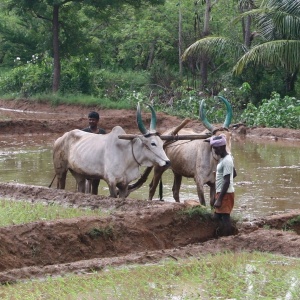
Rice cultivation emits methane and nitrous oxide, which are both more potent greenhouse gases than carbon dioxide. Policies to reduce methane emissions from rice farming generally recommend using intermittent (as opposed to continuous) flooding. However, intermittent flooding could produce much higher nitrous oxide emissions than continuous flooding, according to a recent paper.
The paper found that farms could reduce climate impacts per hectare by 10% to 90%, compared with baseline practices, by managing water, fertiliser and organic matter inputs together. The management practices that achieved these reductions were specific to each farm, and the authors note that the paper’s findings should only be extrapolated to other regions with caution - the paper studied farms on the Indian subcontinent.
Abstract
Global rice cultivation is estimated to account for 2.5% of current anthropogenic warming because of emissions of methane (CH4), a short-lived greenhouse gas. This estimate assumes a widespread prevalence of continuous flooding of most rice fields and hence does not include emissions of nitrous oxide (N2O), a long-lived greenhouse gas. Based on the belief that minimizing CH4 from rice cultivation is always climate beneficial, current mitigation policies promote increased use of intermittent flooding. However, results from five intermittently flooded rice farms across three agroecological regions in India indicate that N2O emissions per hectare can be three times higher (33 kg-N2O⋅ha−1⋅season−1) than the maximum previously reported. Correlations between N2O emissions and management parameters suggest that N2O emissions from rice across the Indian subcontinent might be 30–45 times higher under intensified use of intermittent flooding than under continuous flooding. Our data further indicate that comanagement of water with inorganic nitrogen and/or organic matter inputs can decrease climate impacts caused by greenhouse gas emissions up to 90% and nitrogen management might not be central to N2O reduction. An understanding of climate benefits/drawbacks over time of different flooding regimes because of differences in N2O and CH4 emissions can help select the most climate-friendly water management regimes for a given area. Region-specific studies of rice farming practices that map flooding regimes and measure effects of multiple comanaged variables on N2O and CH4 emissions are necessary to determine and minimize the climate impacts of rice cultivation over both the short term and long term.
Reference
Kritee, K., Nair, D., Zavala-Araiza, D., Proville, J., Rudek, J., Adhya, T.K., Loecke, T., Esteves, T., Balireddygari, S., Dava, O. and Ram, K., 2018. High nitrous oxide fluxes from rice indicate the need to manage water for both long-and short-term climate impacts. Proceedings of the National Academy of Sciences, 115(39), pp.9720-9725.
Read the full paper here. See also the Foodsource resource Carbon footprinting is based on the LCA approach but focuses only on greenhouse gas emissions.







Post a new comment »